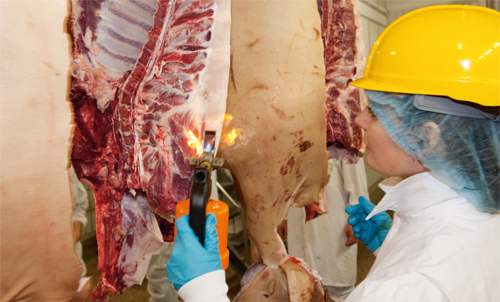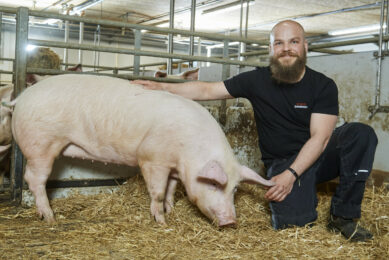First tangible steps to ‘breed out’ boar taint

Could breeding provide solutions to the question -how to get rid of boar taint? Several breeders say ‘yes’, and a first solution has now entered the market. Backed up with some solid scientific research, in its Nador programme, pig breeder Topigs guarantees 40% less boar taint from non-castrated male pigs.
Solving the issue of boar taint has almost become a matter of logic, if you come to think of it. In order to solve the boar taint issue, it is essential to know what boar taint is. The problem is, however, that there is no uniform definition about its components – so how on earth will it be possible to find a solution?
Wait a minute. No uniform definition for boar taint? What about just choosing one, on the basis of that same logic? Dutch breeding organisation Topigs, headquartered in Vught, the Netherlands, defined boar taint as ‘any off-odour that can be detected by a human nose’. “Now that is the only thing that is truly tangible,” says Jean-Marie van Oort, the breeder’s manager of marketing and business development. “In case the pork has a bad smell, it isn’t good for the market.”
Having thus defined its benchmarking concept, the breeder set out to ‘breed’ a strategy to reduce boar taint in finisher pigs.
Having thus defined its benchmarking concept, the breeder set out to ‘breed’ a strategy to reduce boar taint in finisher pigs.
Selecting and sorting
The novel ‘Nador’ concept, an addition to the breeder’s existing portfolio of terminal sires, could be seen as a partial answer to a growing question within the European Union – how to get ready to put a stop to physical castration of piglets by 2018? This ought to happen both for welfare and for feed efficiency reasons. Several pathways to reduce boar taint are being pursued worldwide, but a silver bullet appears hard to find. Nutrition solutions might help – but have so far turned out to be extremely expensive. A futuristic sex sorting research programme was recently terminated in Denmark. And then there is immunovaccination – as for the European markets, the main interest has come from Eastern Europe so far. Partial solutions therefore are the way to go – and this is what the novel breeding programme aims to do: achieve a 40% reduction of boar taint cases in male pigs. The breeder achieved this by sorting the terminal sires.
The novel ‘Nador’ concept, an addition to the breeder’s existing portfolio of terminal sires, could be seen as a partial answer to a growing question within the European Union – how to get ready to put a stop to physical castration of piglets by 2018? This ought to happen both for welfare and for feed efficiency reasons. Several pathways to reduce boar taint are being pursued worldwide, but a silver bullet appears hard to find. Nutrition solutions might help – but have so far turned out to be extremely expensive. A futuristic sex sorting research programme was recently terminated in Denmark. And then there is immunovaccination – as for the European markets, the main interest has come from Eastern Europe so far. Partial solutions therefore are the way to go – and this is what the novel breeding programme aims to do: achieve a 40% reduction of boar taint cases in male pigs. The breeder achieved this by sorting the terminal sires.
Van Oort explains, “In the breeding process, there is a difference between selecting and sorting. Selecting is the hard-core business of a pig breeding company – this includes finding the right animals with desired traits, and then using those animals to breed further and expand the population. With their offspring, the same is done. That way, it is hoped that future generations will also have these same characteristics or on the contrary, miss some of them. All in all, it is a long process.”
Van Oort continues, “Unlike selecting, at sorting we look at an individual animal, and judge whether this animal has certain features.” Sorting is therefore at the core of the Nador concept. First announcements around these breeding initiatives were already made public at EuroTier 2010 and barely 18 months later, the concept has become available to markets in Germany and the Netherlands.
Three criteria
In the Nador programme, a terminal sire low on boar taint is established and cross checked by three criteria: Van Oort says, “First, in the animal itself, the values of androstenone, skatole and indole (ASI) are determined – these components are known for being responsible for boar taint.” By cross-referencing, the breeder established maximum threshold values for each component.
He continues, “Secondly, there is the nose score – by simply allowing a test panel to sniff like pork consumers in a so-called hot iron test, using samples from any boar’s next of kin; this could be litter mates or offspring.”
In the Nador programme, a terminal sire low on boar taint is established and cross checked by three criteria: Van Oort says, “First, in the animal itself, the values of androstenone, skatole and indole (ASI) are determined – these components are known for being responsible for boar taint.” By cross-referencing, the breeder established maximum threshold values for each component.
He continues, “Secondly, there is the nose score – by simply allowing a test panel to sniff like pork consumers in a so-called hot iron test, using samples from any boar’s next of kin; this could be litter mates or offspring.”
Thirdly, and perhaps most importantly – since boar taint is a hereditary trait, DNA from boar tissue can be scrutinised for certain genetic markers for boar taint. Van Oort: “There are certain places in pig chromosomes that determine the levels of boar taint. We have collected and sampled DNA from many pigs and their parents in the last years – and we store these in our DNA bank. A host of data including genomic information from DNA can thus help to establish whether a terminal sire can be called ‘low on boar taint’ (LBT).”
The genomic side, the DNA markers, has been developed within a European consortium (SABRE) where the latest technology developments could be used. Implementation of the whole sorting system was done in a Dutch national consortium. Results on the relation between HNS and ASI are being published, and will be presented to an international public in order to get as much support and to facilitate improvements as soon as possible leading up to the full non-castration approach in Europe by 2018.
Guarantee
About 27,000 non-castrated finisher boars samples have thus been tested by the human nose – this is why the breeder is sure that a 40% reduction of tainted pigs can be claimed, as is shown in Table 1.
The Nador concept is available for three of the company’s sire lines – Top Pi, Tempo and Talent. Each Nador approved boar will cost considerably more than regular boars as full testing takes approximately two weeks.
About 27,000 non-castrated finisher boars samples have thus been tested by the human nose – this is why the breeder is sure that a 40% reduction of tainted pigs can be claimed, as is shown in Table 1.
The Nador concept is available for three of the company’s sire lines – Top Pi, Tempo and Talent. Each Nador approved boar will cost considerably more than regular boars as full testing takes approximately two weeks.
There are, however, ways for producers to win their money back. Apart from the extra benefit from reduction of feed conversion by fattening boars in comparison to castrates, one slaughterhouse has already put in place a premium for Nador-enhanced pigs – Tönnies in Germany. A DNA based system would allow tracing pork from any segment of the pork processing chain or even from a consumer’s plate back to these boars low on boar taint.
At the moment, a reduction of the number of tainted carcasses by 40% is guaranteed – not more, as the breeding pyramid is not (yet) complete. Van Oort points out, apart from boars, there is also female input needed to guarantee a reduction of tainted carcasses by 80%. Complementation by developing low boar taint dam lines is therefore necessary, and the breeder is in the process of offering these. As stated, this is a process of years instead of months – and should not be expected to bear fruit soon. When proper selection has taken place among the sows for this trait – and when the breeder has established this does not come at the expense of various other essential breeding characteristics, this will also be made available to the pig industry.
Sounds logical, after all. PP











